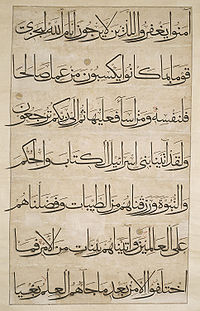
Classical Arabic

The orthography of the Qurʾān was not developed for the standardized form of Classical Arabic. Modern Standard Arabic (MSA) is its direct descendant used today throughout the Arab world in writing and in formal speaking, for example, prepared speeches, some radio broadcasts, and non-entertainment content; it is also used in modernized versions of the Quran and revised editions of poetries and novels from Umayyad and Abbasid times (7th to 9th centuries). While the lexis and stylistics of Modern Standard Arabic are different from Classical Arabic, the morphology and syntax have remained basically unchanged (though MSA uses a subset of the syntactic structures available in CA). In the Arab world, little distinction is made between CA and MSA, and both are normally called al-fuṣḥá (الفصحى) in Arabic, meaning 'the most eloquent'. In the late 6th century AD, a relatively uniform intertribal ‘poetic koiné’ distinct from the spoken vernaculars developed based on the Bedouin dialects of Najd, probably in connection with the Lakhmid court of al-Ḥīra. During the first Islamic century the majority of Arabic poets and Arabic-writing persons spoke a form of Arabic as their mother tongue. Their texts, although mainly preserved in far later manuscripts, contain traces of non-standardized Classical Arabic elements in morphology and syntax. The standardization of Classical Arabic reached completion around the end of the 8th century. The first comprehensive description of the ʿarabiyya 'Arabic', Sībawayhi's al-Kitāb, is based first of all upon a corpus of poetic texts, in addition to the Qurʾān and Bedouin informants whom he considered to be reliable speakers of the ʿarabiyya. 'Colloquial' Arabic refers to the many regional dialects derived from Arabic spoken daily across the region and learned as a first language, and as second language if people speak other languages native to their particular country. By the 8th century, knowledge of Classical Arabic had become an essential prerequisite for rising into the higher classes throughout the Islamic world, as it was the lingua franca across the Middle East, North Africa, Horn of Africa during those times; the analogy is like most literate Romance speakers were also literate in Classical Latin. Various Arabic dialects freely borrowed words from Classical Arabic, this situation is similar to Romance languages, wherein scores of words were borrowed directly from Classical Latin. People speak Classical Arabic as a second language if they speak colloquial Arabic dialects as their first language, but as a third language if others speak other languages native to a country as their first language and colloquial Arabic dialects as their second language. But Classical Arabic was spoken with different pronunciations influenced by informal dialects. The differentiation of the pronunciation of informal dialects is the influence from native languages previously spoken and some presently spoken in the regions, such as Coptic in Egypt, Berber, Punic or Phoenician in North Africa, Himyaritic, Modern South Arabian and Old South Arabian in Yemen, and Aramaic in the Levant.
